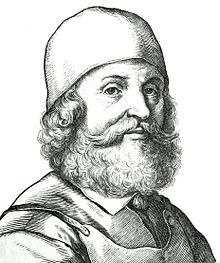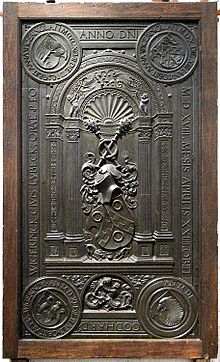Peter Vischer the Elder
Peter Vischer the Elder (* around 1455 in Nuremberg ; † January 7, 1529 there ) was a German sculptor and redsmith from the Nuremberg artist family Vischer .
Life
Trained by his father Hermann († 1488), Vischer took over the brass foundry he founded in 1453, which under his direction became the most famous in Germany . Vischer first appeared in the Nuremberg council exits in 1488, the year his father died; the master list only led him since 1489. In 1485 at the latest he married his first wife Margarethe Groß. He was the father of Hermann (around 1486–1516), Peter (1487–1528), Hans (around 1490–1549), Jakob and Paul († 1531). At the beginning of 1493 his father's house on the sand passed into his possession; in the same year his second wife Dorothea died. In 1494, the Nuremberg Council, together with the carver Simon Lainberger, placed him at the Heidelberg court of Count Palatine Philip the Sincere (1448–1508). In 1505 he was already living on the Lorenzer side “at the Katharinengraben” and as a house owner “was given to a captain in the barefoot quarter”. In 1506 he and his third wife Margaretha († 1522) bought the neighboring house and built a foundry. In 1511 the city council appointed him together with Albrecht Dürer (1471–1528) as an expert for the repair of the beautiful fountain (1385–96) on Nuremberg's main market . In 1516 he was accepted into the “Greater Council” as “named”.
During his early creative period, full-figure grave slabs such as the brass tomb of Archbishop Ernst of Saxony (1464–1513) erected in Magdeburg Cathedral around 1495 were created . Vischer used drafts and models for his casts, the authorship of which has not yet been fully clarified. Whether he was active as a visual artist himself is controversial. After 1500 he probably also worked with Veit Stoss . Emperor Maximilian I (1459–1519) noted in his memorial book: "... maister Peter Rotschmid zu Nurmberg let the old Frenkischen pild paint from 3 to 400, ..." (perhaps a collection of sights and traces). In 1512 Maximilian commissioned two life-size bronze statues - most likely the kings Arthur and Theoderich (Guss 1513) - for his planned grave monument in the Innsbruck court church from Vischer.
The Sebaldus grave in the east choir of St. Sebald in Nuremberg is the main work of the Vischer workshop and an important testimony to German Renaissance sculpture . The large-format plan (pen drawing on parchment , Vienna , Academy of Fine Arts) for the tabernacle-like housing for the reliquary of St. Sebaldus made in 1391-1397 shows Gothic architectural forms, drawn in 1488 and provided with a Vischer's workshop mark . In May 1507 the Nuremberg Council decided to have the brass case made. It was based on a modified and North Italian Renaissance art heavily committed design, which reduced the size of the case and figuratively richly furnished. The base of the Sebaldus grave shows the start of work (1508) and the name of the master. According to the signature on the edge of the base plate, Vischer completed the work together with his sons in 1519. The expressive (self?) Statue of Vischer stands in the niche on the eastern side of the Tumba of Sebaldus.
Peter Vischer was buried in the Rochusfriedhof in Nuremberg. Of the five sons from three marriages, the two eldest, Hermann and Peter, were characterized by unusual creative creativity, whose full development, however, prevented their untimely death.
In 1999 the asteroid (9610) Vischer was named after him. In Nuremberg there is a street named after him, as well as a school with a grammar school and a secondary school. It was built in 1914, served as a town hall during World War II and was also used as a hospital.
A street is also named after him in Erlangen ( Alterlangen district ), as well as in Berlin , Höchstadt an der Aisch and Amberg in the Upper Palatinate . There is a primary school in Dortmund that bears his name. A bust, made by Ferdinand Müller in 1839 , is in the Walhalla memorial . During the construction of the Düsseldorf Art Academy , his name was chiseled among the important sculptors on the west side (Rhine side), just as his likeness was previously in the academy's picture gallery . This is now located in the inner courtyard of the Düsseldorf town hall complex on Burgplatz.
progeny
His marriages gave birth to five sons, all of whom worked in the foundry that his grandfather had founded in 1453. Among them are:
- Hermann the Younger (* around 1486 in Nuremberg; † January 1, 1517 ibid) was studying in Italy in 1516/17; the second draft of the Nuremberg Sebaldus grave probably came from him after the father's first draft was rejected by the Nuremberg Council, but it then executed.
- Peter the Younger (* around 1487 in Nuremberg; † 1528 ibid) created the figurative ornamentation of the Sebaldus grave with his father, also grave monuments and medals, whereby he combined his father's style with Italian forms.
- Hans (* around 1489 in Nuremberg; † September 8, 1550 in Eichstätt ) took over the foundry workshop in 1529 in the third generation.
Works
- Grave slab for Margaret of Austria, Electress of Saxony, 1486, (Altenburg, Castle Church)
- Grave slab for Ulrich Rißpach, from 1474 to pastor in Stolberg, 1488 (Stolberg / Südharz, St. Martini)
- Chandelier, 1488/89 ( Nuremberg , St. Lorenz )
- Statuette of a kneeling man, so-called branch breaker, 1490 ( Munich , Bavarian National Museum )
- Grave slab for Bishop Heinrich III. von Bamberg , 1492 ( Bamberg , Cathedral ) and for the two subsequent bishops Veit I and Georg II.
- Grave tumba of Archbishop Ernst of Saxony, 1495 ( Magdeburg , Cathedral )
- Grave epitaph for Bishop Johann IV. Roth , 1496 ( Breslau , Dom )
- Grave slab for Philippus Kallimachus, 1496 ( Krakow , Dominican Church )
- Tomb slab for Piotr Kmita, 1505 ( Krakow , Wawel Cathedral Krakow )
- Grave slab of Elisabeth von Stolberg, 1505 (Stolberg / Südharz, St. Martini)
- Statuette of St. Mauritius, probably 1507 ( Nuremberg , Germanisches Nationalmuseum )
- Hunting dog ( Nuremberg , Germanisches Nationalmuseum )
- Sebaldusgrab , 1508/19 ( Nuremberg , St. Sebald )
- Tomb for Count Hermann VIII von Henneberg and his wife Elisabeth , 1510 ( Römhild , collegiate church )
- Grave slabs of Duke Albrecht, Duchess Amalie and Duchess Sidonie in the Meissen Cathedral
- Bronze figures of Arthur and Theodoric on the tomb of Emperor Maximilian I , 1512/13 ( Innsbruck , Hofkirche )
- Final lattice of the Fugger Chapel , from 1512 (completed by the sons?) ( Augsburg , St. Anna Church)
- Grave slab of Godart Wigerinck, who died in 1518, in the Marienkirche in Lübeck (collaboration with his sons)
- Table grave with reclining figure of the Brandenburg Elector Johann Cicero , erected around 1530 in the Lehnin Monastery (later in the Berlin Cathedral)
literature
- Paul Johannes Rée: Vischer . In: Allgemeine Deutsche Biographie (ADB). Volume 40, Duncker & Humblot, Leipzig 1896, pp. 16-30.
- Simon Meller: Peter Vischer the Elder and his workshop. Insel-Verlag, Leipzig 1925.
- Karl Sitzmann : Artists and craftsmen in Eastern Franconia (= Die Plassenburg. Volume 12, ZDB -ID 504385-2 ). Friends of Plassenburg, Kulmbach 1957, p. 159.
- Fritz fighters: Peter Vischer. Verlag der Kunst, Dresden 1960.
- Karl Oettinger : Maximilian's sculptors at the Innsbruck Imperial Tomb (= Erlangen contributions to linguistics and art studies. Volume 23, ISSN 0425-2268 ). Carl, Nuremberg 1966.
- Kurt Pilz: The Sebaldus tomb in the east choir of St. Sebaldus Church in Nuremberg. A brass casting from the Vischer foundry. Carl, Nuremberg 1970.
- Sven Hauschke: The tombs of the Nuremberg Vischer workshop. (1453–1544) (= bronze devices of the Middle Ages. Volume 6). Imhof, Petersberg 2006, ISBN 3-86568-015-1 (also: Augsburg, Universität, Dissertation, 2003).
- Gerhard Weilandt: The Sebalduskirche in Nuremberg. Image and Society in the Age of Gothic and Renaissance (= studies on international architecture and art history. Volume 47). Imhof, Petersberg 2007, ISBN 978-3-86568-125-6 .
- H. v. C .: A great master and his greatest work . In: The Gazebo . Issue 32, 1867, pp. 501, 502–504 ( full text [ Wikisource ] - with illustration by Rudolf von Seitz ).
Web links
- Literature by and about Peter Vischer the Elder in the catalog of the German National Library
Individual evidence
- ↑ Minor Planet Circ. 34354 (PDF)
| personal data | |
|---|---|
| SURNAME | Vischer, Peter the Elder |
| BRIEF DESCRIPTION | German sculptor and ore caster |
| DATE OF BIRTH | around 1455 |
| PLACE OF BIRTH | Nuremberg |
| DATE OF DEATH | January 7, 1529 |
| Place of death | Nuremberg |




